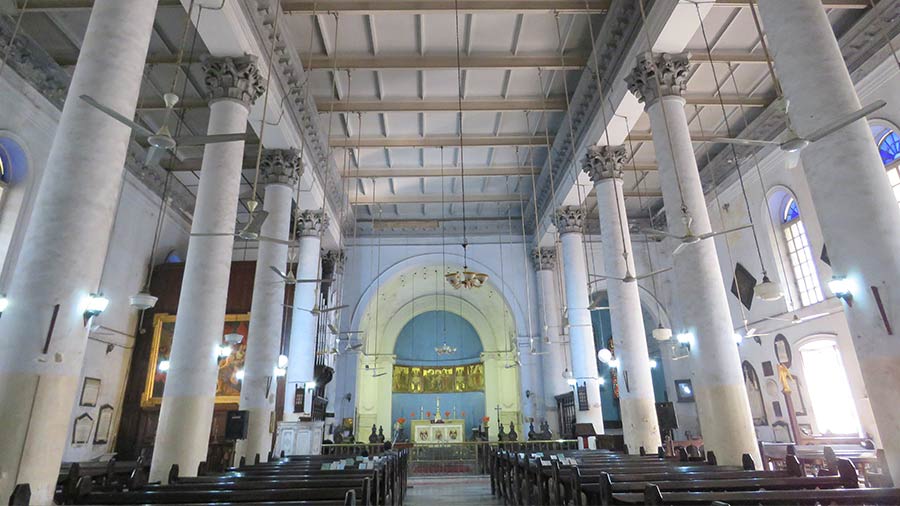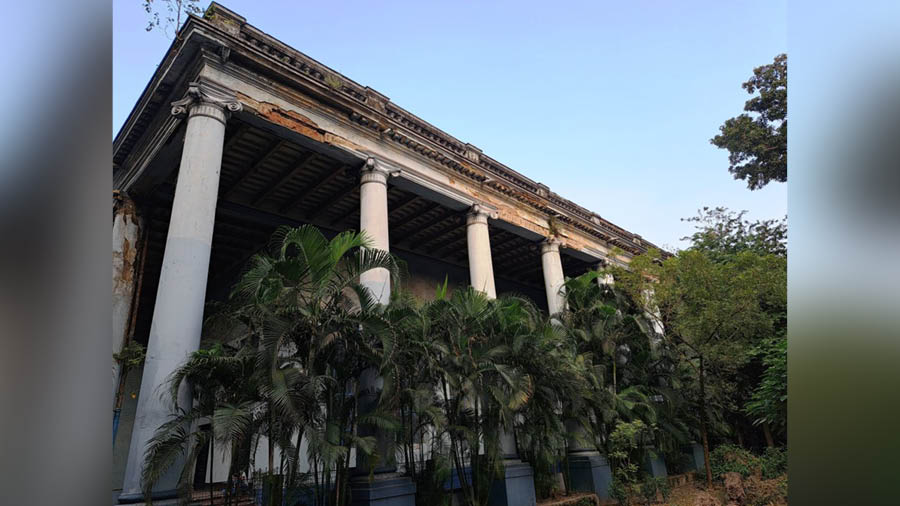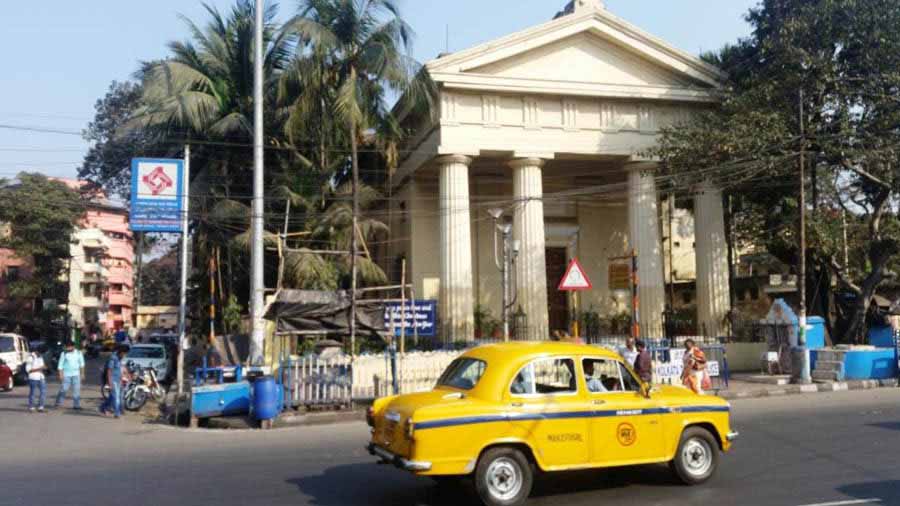The St John’s Church, which is now frequented by heritage walkers, is perhaps the biggest open air museum in Calcutta that encapsulated nearly two hundred years of British political emergence in Bengal. Its courtyard, which is decorated with innumerable tombstones, war memorials, stone tablets, graves, paintings and other historical artifacts, is a goldmine for one who is interested in knowing Calcutta’s history and growth of the British East India Company from Bengal.
This oldest Anglican cathedral of Calcutta is also the third oldest church that this city had. History says that the first church established by the East India Company was named St Anne’s church and it was located somewhere near the south – west of present Writer’s building. The church established in 1713 was destroyed by Siraj’s army in 1856 and its last priest Rev Garvas Belami was killed in a famous blackhole massacre inside Fort William.
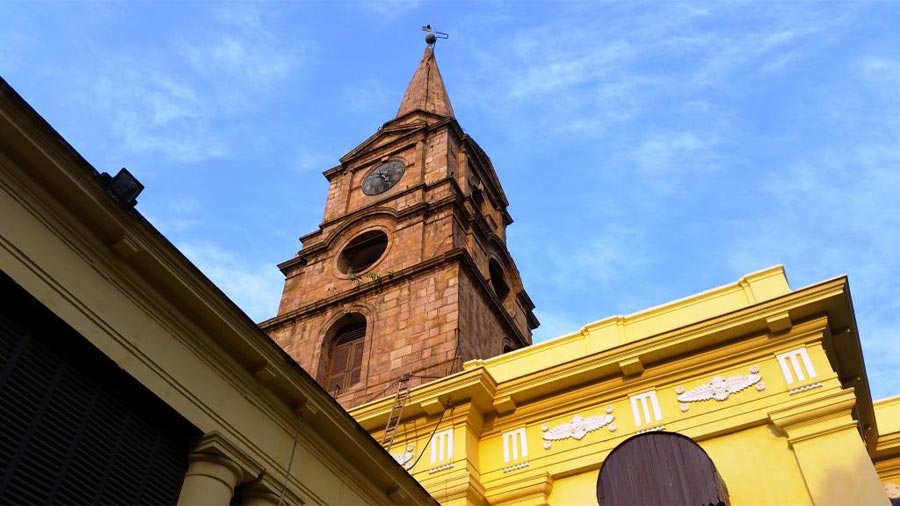
St. John's Church near Raj Bhavan
In 1770, Mission Church was established and six years after that in 1776, one William Johnson appealed to the council of the company for building a new church. Thanks to its cemented political position in India and growing European population in Calcutta, East India Company finally sanctioned a plan to establish a premier church in Calcutta and the idea of St John’s came into existence. It was approved in 1782 and land was purchased from Raja Naba Krishna Deb of Shobhabazar for Rs 10,000. In 1783, a committee was formed by Warren Hastings and in 1785, a trust was formed to build a church and meanwhile Johnson himself collected Rs 35,950 by lottery.
The foundation stone was laid on April 6, 1784, in the presence of Warren Hastings.
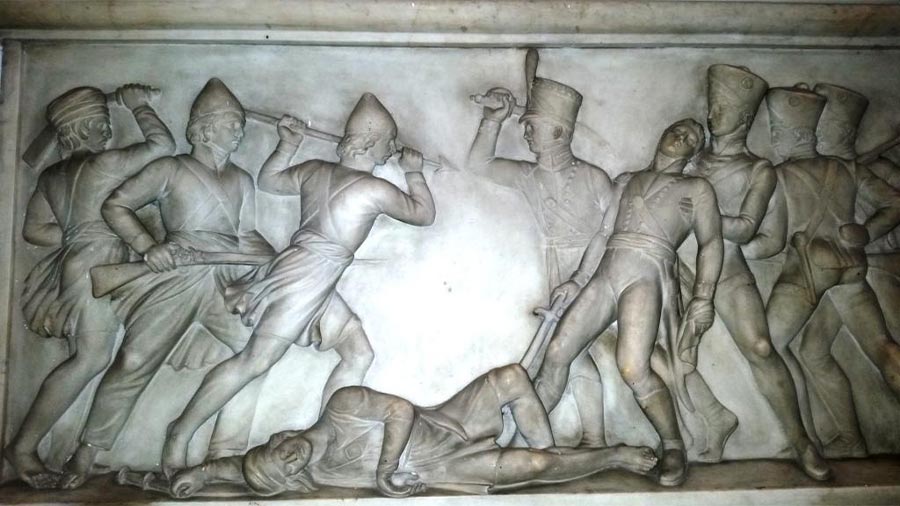
A stone sculpture inside the church
A design was done by James Agg of Bengal Engineers, who was profoundly influenced by St Martin church of London. The church, designed in typical Indo-Gothic classical style with a pointed spire and plethora of roman pillars in front portico and side, was finally completed in 1787. It is assumed that the stone used in spires and floors were taken from the ruins of Gour in Malda but recently citizen historian Subhadip Mukherjee who had seen the archive of the church has claimed that these stones were actually ordered from Chunar and not taken from Gour. However thanks to its usage of stone the church is known as “Pathure Girja” as well.
The church at the time of its construction was 201 ft high up to its pinnacle and 81 ft wide and 247 ft long. However, after 200 years and with many renovations, its measurement and shape has changed.

Job Charnock's tomb on the church premises
It was consecrated on June 24, 1787, in the presence of Bishop Wilson and Lord Cornwallis. It was initially known as the new church or the Presidency Church. In 1814, it became a cathedral.
Till the time St Paul’s Cathedral came into existence on October 8, 1839, St Paul’s was the main Cathedral for protestant Christians in Calcutta. The first four Bishops of the church were Middleton, Heber, James and Tarner.
Why is St John’s so distinctive from other churches of Calcutta?
The answer lies in its walled compound and inside. The compound houses the mausoleum of Job Charnock, the so-called founder of Calcutta and his daughters Marry Ere and Catherine who died on January 10, 1692 and January 21, 1700 respectively.

Holwell’s monument inside the compound
Near to that stands the infamous Calcutta Black Hole Monument, an excellent memorial edifice established by Lord Curzon near Writers Building in 1901 in the memory of those 123 Europeans who were asphyxiated to death by Siraj’s army in 1756. As this issue was never accepted by Indians, a movement executed in 1940 by Muslim League and supported by Subhash Chandra Bose forced the monument known as Holwell’s monument uprooted from Dalhousie square to this church ground. It is an excellent piece of work.
In one of the small monuments, one can find a priceless piece of plaque that contains the memorial details of those British soldiers who died in World War I. It was earlier placed in the Glorious Death war memorial on Maidan and later to save it from public vandalism, it was shifted here. The church wall contains one more World War I memory in the form of a thanksgiving tablet dedicated to a grateful mother for the safe return of his two sons from the battlefield.
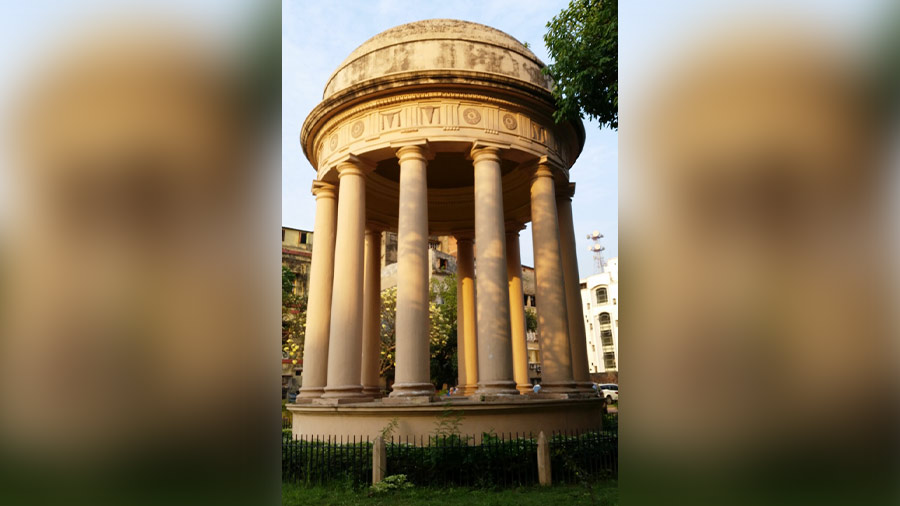
Rohilla War Memorial
The church has an excellent war memorial named 2nd Rohilla War Memorial. It was dedicated to all fallen British soldiers who participated in the 2nd Rohilla War under the leadership of General Sir Robert Abercromby.
One of the most exceptional mausoleums of this ground is of Francis Johnson, also known as Begum of Calcutta. Born in Madras on April 10, 1725 and lived till February 3, 1812, this lady was a point of attraction of Calcutta once upon a time for her excellent skill of hospitality and storytelling. Married four times and lastly to Watson, she had rich experience of seeing a tumultuous time of East India Company. At the last stage of her life, she became Calcutta’s first up-scale lady who used to entertain elite Europeans at her house for evening parties and socialising. She obtained permission from Lord Wallesly to get herself buried inside of the church. On her grave is written: “The Oldest British resident in Bengal universally beloved, respected and revered”. Her mausoleum is unique in its architecture.

A replica of Lady Canning's grave
On the back of the church there is a replica of Lady Charlotte Canning’s grave. Her original grave is in Barrackpore.
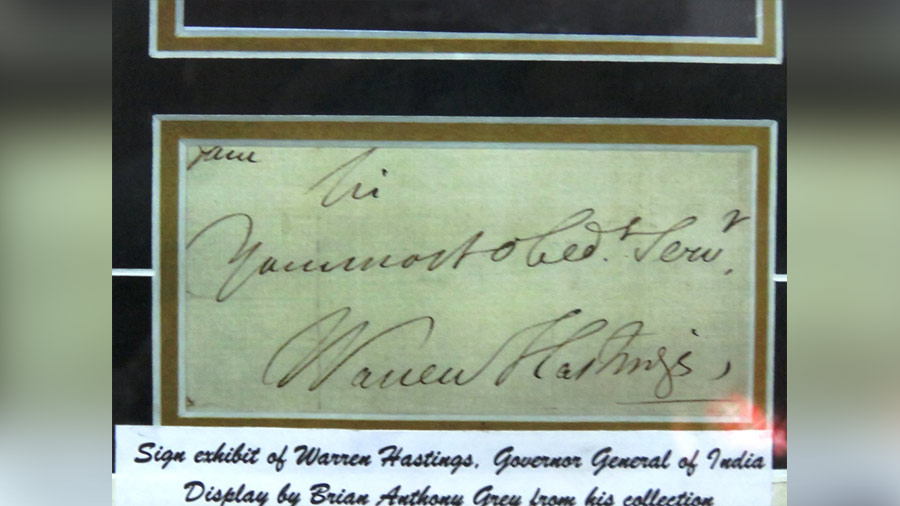
Signature of Warren Hastings on display
The first room on the right of the church, which is now used as a church office, contains several important historical articles. One such is the chair used by Warren Hastings. His original signature and a clock used by him are also on display in the room, but this room is not open to common people.
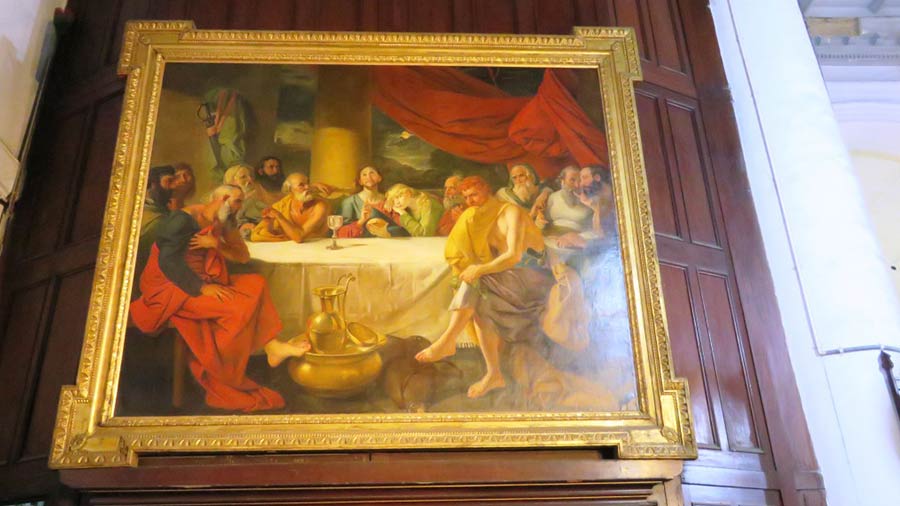
The Last Supper by Zoffany
Inside the church, there is a stunning painting of “Last Supper” done by Johann Zoffany. This is just one of its kind paintings as no church in Bengal has a painting like this. This painting of Zoffany was done with Indian influence and his experience in Calcutta. It is believed that Zoffany intentionally painted faces of Jesus and others by copying faces of his friends and foes.While the face of Jesus was done in resemblance of his friend Father Pathenio of Greek church the face of Judas was done in line of William Tulloh with whom the painter had a bitter relation. This excellent piece of work is placed on the left side of the main nave path.
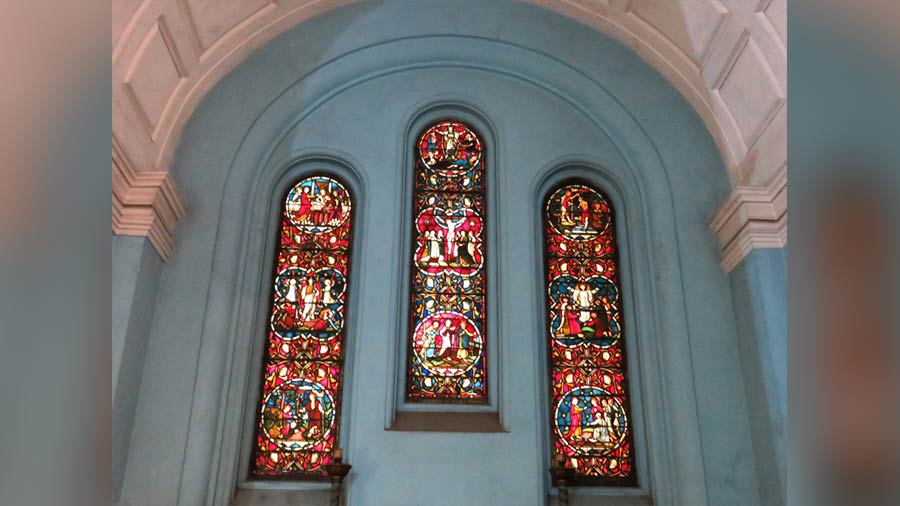
Glass paintings on the walls
Inside the church, there is a stunning painting of “Last Supper” done by Johann Zoffany. This is just one of its kind paintings as no church in Bengal has a painting like this. This painting of Zoffany was done with Indian influence and his experience in Calcutta. It is believed that Zoffany intentionally painted faces of Jesus and others by copying faces of his friends and foes.While the face of Jesus was done in resemblance of his friend Father Pathenio of Greek church the face of Judas was done in line of William Tulloh with whom the painter had a bitter relation. This excellent piece of work is placed on the left side of the main nave path.
The nave path is decorated on both sides with an array of Corinthian pillars and at the end of the nave, the altar wall contains three paintings from the life of Jesus. The church also has a side altar that ends on a wall decorated with colorful stained glass.
Out of the plethora of eye-catching dedicatory wall tablets, some of them are decorated with excellent figures of human and floral designs. One such is dedicated to James Achilles Kirkpatrik. the man who took an Indian Muslim wife from an orthodox Hyderabadi royal family and whom William Dalrymple has immortalised in his novel White Mughals. The man died in 1804 and this was dedicated to him by his father and brother.
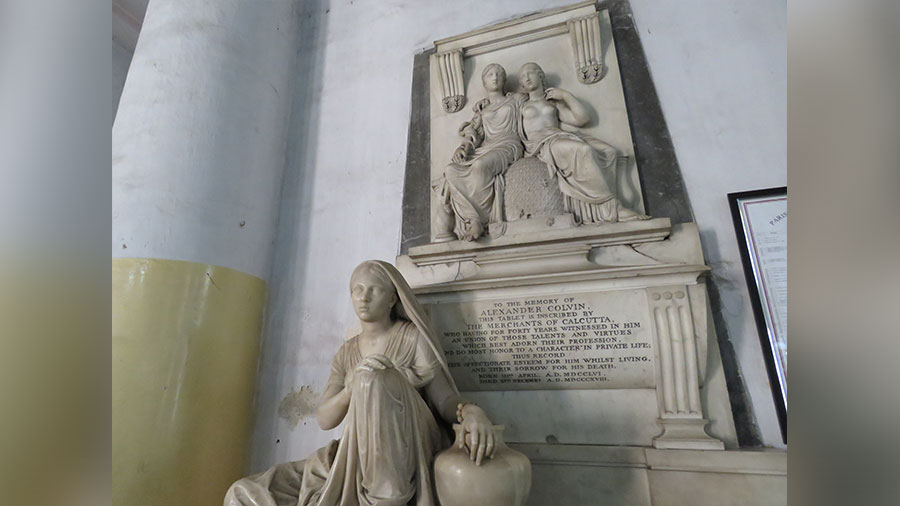
A memorial tablet inside the Church premises
The stone tablet in the memory of Charles Lionel Showers, Humphry Bagot and Wilson Broughton is an excellent one. Its bottom part holds a marble carving of a war scene, which is exceptionally beautiful.
Memorial tablets of James and Adeline Pattle, who were buried in sea and Lieutenant Peter Lawtie are some of the important things to see. The memorial tablet of Alexander Calvin, one of the rich businessmen of Calcutta, has a statue of a woman in Indian sari with a kalash holding in one of her hands. This is interestingly exceptional.
The pipe organ of the church is still in use and one of the oldest in Calcutta.
During World War II, the church was directly hit by Japanese bombing in 1942-43. Though one part of the church was damaged, it was lucky to escape from any major damage.
